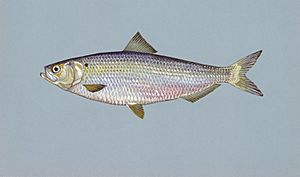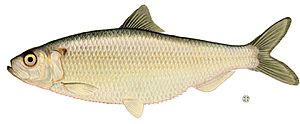Blueback herring facts for kids
Quick facts for kids Blueback herring |
|
|---|---|
 |
|
| Conservation status | |
| Scientific classification |
The blueback herring (Alosa aestivalis) is a type of herring fish found along the east coast of North America. These fish live in the ocean but swim up rivers to lay their eggs. This journey is called being anadromous. You can find them from Nova Scotia in Canada all the way down to Florida in the United States. Blueback herring often swim together in large groups called schools. Scientists believe they spend winter deep in the ocean.
Blueback herring are shiny and silver. They have a deep bluish-green color on their backs. Along their bellies, they have special, spiny scales called scutes. These fish can grow up to about 40 centimeters (16 inches) long and can live for up to 8 years. A special way to tell them apart is the dark, almost black, lining inside their belly (called the peritoneum).
These fish are often confused with another fish called the alewife. It's hard to tell them apart, so people often call both of them "river herring." Alewives usually have bigger eyes, a deeper body, and a pearly white lining inside their belly, which is different from the blueback herring's dark lining.
In the past, blueback herring were used as bait for catching lobsters. People also eat them, especially when they are smoked. Fishermen catch them during their journey up rivers using large dip nets. They scoop the fish out of shallow, narrow parts of the rivers.
Contents
Where Do Blueback Herring Live?
Blueback herring naturally live along the Atlantic Coast. Their home range stretches from Cape Breton, Nova Scotia, down to the St. Johns River in Florida. When it's time to lay eggs, they swim into coastal rivers.
New Homes for Blueback Herring
Sometimes, blueback herring are found in places where they don't naturally live. This happens when people move them or they find new ways to travel. For example, blueback herring were first seen in Lake Ontario in 1995. They have also been found in parts of the Tennessee River and in several lakes and rivers in New York, like Oneida Lake and Lake Champlain.
In North Carolina, blueback herring were put into rivers like the Savannah and Broad. They have also been found in places like Lake Jocassee in South Carolina and some lakes in Virginia. They are now living and reproducing in new areas like Texas, New York, North Carolina, Vermont, and Virginia.
How Blueback Herring Live
Blueback herring are anadromous fish. This means they spend most of their lives in the ocean but travel to fresh water to lay their eggs. They prefer deep, fast-moving rivers with rocky bottoms for spawning.
They migrate to their spawning grounds in the spring. In places like Connecticut, blueback herring lay their eggs when the water temperature is between 14 and 17 degrees Celsius (57 to 63 degrees Fahrenheit). This is usually a bit later in the spring than alewives. During spawning, the female fish lay many eggs on the river bottom. The eggs stick to gravel, stones, or logs. Young blueback herring stay in fresh water for three to seven months before they swim out to the ocean.
Blueback herring are also known as a "planktivorous forage species." This means they eat tiny plants and animals floating in the water (plankton). They are also an important food source for other animals.
Blueback Herring Family Life
Blueback herring lay their eggs from late March to mid-May, depending on how far north or south they are. Female blueback herring usually start laying eggs when they are about five years old. Each female can produce between 60,000 and 103,000 eggs! Males usually become ready to reproduce earlier, when they are 3 to 4 years old, and are smaller than the females.
After laying their eggs, both male and female adult fish quickly swim back downstream to the ocean. Scientists don't know much about what they do in the ocean, but they think these fish can travel very long distances, sometimes over 1,900 kilometers (1,200 miles).
Keeping Blueback Herring Safe
The number of blueback herring has dropped a lot in many places where they live. There are several reasons for this decline:
- Loss of habitat: Dams and other structures built in rivers make it hard for the fish to reach their spawning areas.
- Habitat damage: Pollution and other changes can harm the places where they live and lay eggs.
- Fishing: Too much fishing can reduce their numbers.
- More predators: The number of striped bass, which eat blueback herring, has increased, leading to more fish being eaten.
Because their numbers are going down, some states like Alabama, Massachusetts, Rhode Island, Connecticut, Virginia, Delaware, and North Carolina have stopped people from catching or owning blueback herring.
The blueback herring is listed as a "Species of Concern" by the U.S. National Marine Fisheries Service. This means the U.S. government is worried about their status and the threats they face. However, there isn't enough information yet to list them under the U.S. Endangered Species Act, which would give them more protection.
See also
 In Spanish: Alosa aestivalis para niños
In Spanish: Alosa aestivalis para niños



